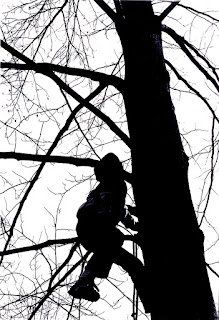Grace Episcopal Church, Galveston
Gospel: John 15:1-8
Gospel: John 15:1-8
29 April 2018
I’m an amateur photographer and an image aficionado. The best photos for me are everyday images that also carry a timeless meaning. For example, I was learning photography at Sewanee when I made an image of a boy climbing a tree. I underexposed the negative and overexposed the print to create a black and white silhouette...you could tell that it was a boy climbing a tree, but the silhouette effect helped underscore that the particulars were not what was important. For me, the image was about growing up. It begged the question, “How is climbing a tree like the journey from child to adult?”
I suppose nowadays children are not encouraged to climb trees. There are much safer climbing structures at schools and parks. My childhood experience scaling an old oak tree was during summer visits with my cousins who lived on a dairy farm. My same-aged cousin and I were practically turned loose to entertain ourselves on long summer days...and the big oak tree beside the dairy “called” to us in good weather. We figured out how to climb to a spot among the branches, where we could sit and drink Nehi “belly wash.” Getting to that point was tough, at one point the main branch lacked limbs but bent just enough that the climber could bear-hug the tree and shimmy up until a handhold was available. We learned the hard way that short-sleeved shirts and pants offered no protection from the rough bark.
Now that I’m “high mileage,” so to speak, the image speaks to me of the journey of life, as a whole, as much as to that small part we associate with “growing up.” Life has periods that are easy and periods that are difficult. Sometimes, we suffer scrapes, other times we find places to stop for a time and reflect on where we’ve been. Eventually, we find that we’ve gone as far as we can go. One picture can surely evoke more than a thousand words on such a timeless subject. One picture can evoke greater understanding.
Jesus did not take photographs but he certainly used images in his teaching. He taught with parables which compared situations of everyday life to the Kingdom of Heaven. He used what people already knew to help them gain insight on the new thing that God was doing in their midst. I can imagine the written discourse in today’s Gospel reading going all the way back to Jesus and his disciples having discussions about how the new community, known by its love, was like the branches of a grapevine.
Last Sunday the ordinary image of a shepherd was transformed into Jesus, the good shepherd. This Sunday the ordinary image of a grapevine becomes Jesus, the true vine. In each case, a mental picture was used to evoke a greater understanding of Jesus.
The image of the grapevine would not have been lost on Jesus’ Jewish listeners. In both the Psalms and the Prophets, Israel is represented as a vine planted by God. While Israel was disobedient to God, Jesus, by contrast, was faithful even to the point of laying down his life. Thus, the true vine is Jesus. The Church is made up of many branches...we are the branches. And without the vine the branches are dying twigs. People like you and me become the Church, the community of faith, by abiding in Jesus and bearing fruit.
This grapevine image is ripe with meaning, but I’ll limit myself to just noting a few points...just three ideas on how this one image can evoke greater understanding.
1) Jesus notes the presence of the Father as the vine-grower. The image of a working vineyard includes one who tends to the plants. This image-metaphor evokes the understanding of God as one who walks with us and who is intricately involved in our lives. Our God did not create us and leave for some distant place, abandoning us to our own devices. Our God abides in us; we call this companion-God the Holy Spirit.
2) Branches that begin to bear some fruit will later produce more and more fruit under the vine-grower’s supervision. The description of branches responding to the vine-grower’s pruning evokes an understanding of the Christian life as being one of transformation. God is with us, and God is not done with us yet. With God abiding in us, we have power to grow toward the perfection for which we were created….although, not reaching it completely in this life and knowing there will be stumbles and setbacks for which we will have the vine-grower’s loving attention.
3) Finally, a branch can only live if it abides in the vine. Disconnected from the water and nutrients in the vine, a branch becomes unproductive, withers, and dies. Just as our bodies need physical food to live, our bodies also need spiritual food for strength to obey God’s commandments. Abiding in Jesus evokes an understanding of a worshipping community where we are fed with the study of scripture, with the fellowship of other pilgrims, and with the very life of Jesus made known to us in the breaking of the bread. AMEN.


No comments:
Post a Comment